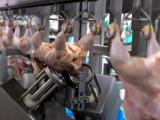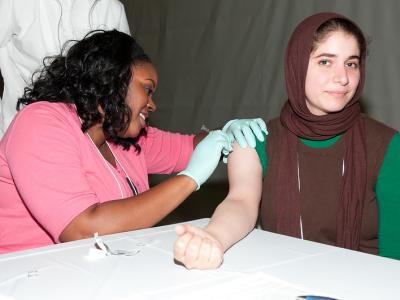Sep 16, 2004 (CIDRAP News) – A nationwide survey by the Food and Drug Administration (FDA) suggests that risk factors for foodborne disease, such as inadequate handwashing by workers and keeping food at unsafe temperatures, are very common in the nation's restaurants, retail stores, and institutional food services.
Observations by FDA personnel at more than 900 food operations in 2003 showed that sizable percentages of them failed to comply with guidelines for food holding time and temperature, personal hygiene, and keeping equipment clean, according to a 200-page FDA report released this week.
For example, the FDA found failures to comply with handwashing guidelines in 73% of full-service restaurants and 34% of hospitals. Further, inspectors saw cases of noncompliance with guidelines for cleaning food-contact surfaces in 58% of retail deli departments and 25% of elementary schools.
The new findings echo those of a similar survey conducted in 1998 and reported in 2000, according to the FDA. "The same risk factors and data items identified as problem areas in the 2000 report remain in need of priority attention," the report says. "This indicates that industry and regulatory efforts to promote active managerial control of these risk factors must be strengthened."
The FDA survey team visited nine types of food establishments: fast-food and full-service restaurants; hospitals, nursing homes, and elementary schools; and retail deli, meat and poultry, seafood, and produce departments.
Team members gathered information on 42 food safety variables by directly observing facility operations and, in some cases, by talking with managers and workers. The variables—described in the FDA Food Code—were grouped into several risk factors, including improper holding time and temperature, poor personal hygiene, inadequate cooking time, contaminated equipment/prevention of contamination, food from unsafe sources, and "other/chemical" hazards.
Failure to heed guidelines for food holding times and temperatures appears to be the most common problem noted in the report. The FDA found problems of this kind in 63.8% of full-service restaurants, 64.4% of delis, 41.7% of fast-food restaurants, and 40.3% of hospitals. The most common specific problems were "improper cold holding of potentially hazardous food" (for example, not storing food at 41ºF or lower) and failure to date-mark refrigerated ready-to-eat foods after 24 hours.
In the personal hygiene category, inadequate handwashing was the most common specific problem in all nine types of facilities, the report says. For personal hygiene overall, samples of the noncompliance rates included 31.2% for fast-food restaurants, 41.7% for full-service restaurants, 23.5% for deli departments, and 17.5% for hospitals.
Contaminated equipment was also common, according to the report. For example, failures in this category were observed in 21.9% of fast-food restaurants, 37.3% of full-service restaurants, 23.4% of delis, 24.4% of retail meat and poultry departments, 18.9% of hospitals, and 13.5% of elementary schools.
Within the general area of contaminated equipment, improper cleaning and sanitizing of food-contact surfaces was the most widespread specific problem. Noncompliance ranged from 25% in elementary schools to 35.2% in retail seafood departments, 37.2% in nursing homes, and 58% in deli departments.
Inadequate cooking time was a less common problem than most of the others, the FDA says. Inspectors reported it, for example, in 15.8% of full-service restaurants and 6.3% of hospitals. The use of food from unsafe sources was also reported relatively infrequently.
The FDA compared food safety data from establishments that had a certified food protection manager from a recognized program with data from establishments that lacked such a manager. The comparison suggests that having a certified manager improves the control of certain risk factors, especially poor personal hygiene. This effect was seen most clearly in restaurants, meat and poultry departments, and produce departments, the report says.
The FDA has a goal of reducing the overall noncompliance rate for each type of food establishment by 25% by 2010, using the 1998 survey as a baseline, according to the report. For example, in 1998, the overall noncompliance rate for all the risk variables in elementary schools was 20%; the FDA would like to reduce that to 15% by 2010. The agency plans to do a third nationwide survey in 2008.
The report notes that the ideal measure of food safety performance in the foodservice industry would be the actual level of foodborne illness. But because foodborne illness is "grossly underreported," illness data are an unreliable indicator. Thus the FDA chose to assess foodborne disease risk factors, as defined by the Centers for Disease Control and Prevention.
See also:


















